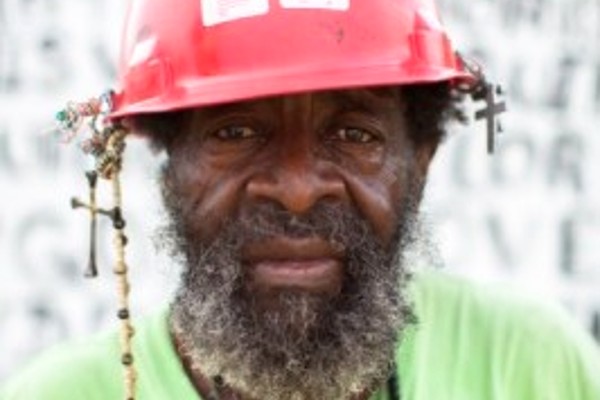 Using state-of-the-art imaging technology, Souls Grown Deep Foundation and Community Partnership in collaboration with The University of Alabama is digitally documenting and preserving African Village in America.
Using state-of-the-art imaging technology, Souls Grown Deep Foundation and Community Partnership in collaboration with The University of Alabama is digitally documenting and preserving African Village in America.
Joe Minter’s nearly one-acre art environment in Birmingham, AL. The mapping and digital documentation of Minter’s work will be the first large-scale application of this sophisticated mapping and imaging technology to record and preserve an art installation. When it launches online in fall 2022, the digital rendering will offer immediate access to the artist’s site-specific presentation of found-object sculptures for both scholars and the public, who previously could only experience the monumental environment by visiting in person. With Minter as the sole creator and caretaker of African Village in America, Souls Grown Deep and The University of Alabama’s project will also ensure that this work remains archived for generations to come.
Dedicated in part to increasing the representation of Black artists from the Southern United States in the art historical canon, Souls Grown Deep is committed to fostering public access to the works by artists in its collection, as well as preserving these works in perpetuity. By working with The University of Alabama to create this digital reproduction of Minter’s environment, Souls Grown Deep and the artist will be able to leverage these visuals as a resource to generate support for its physical preservation as well.
“Given the physical magnitude, art historical importance, and vulnerability of African Village in America, it was imperative that we use this groundbreaking technology to create a record of this one-of-a-kind work of art,” said Maxwell L. Anderson, president of Souls Grown Deep. “Too many significant art environments have been lost to history; it’s our hope that like-minded foundations, museums, and universities will see this project as a model for future, equally urgent efforts to preserve and make more accessible site-specific art that cannot be easily transferred to a collection or institution.”
Initiated in 1989, African Village in America is part yard show, part sculpture garden, and part memorial: a transformation of the land-near two historically Black cemeteries-abutting Minter’s home. In consideration to the site’s history, Minter’s work provides recognition to both the millions of Africans shipped in bondage to America and their descendants. Using found materials as well as natural objects, Minter, a former construction worker, has welded iron to form commemorations, from a room-size re-creation of the Birmingham jail cell that held Dr. Martin Luther King Jr. to a monument to those murdered at Sandy Hook Elementary. Biblical scenes and signage are featured throughout the environment, as well as tributes to Black scientists and civil rights leaders. Works by Minter are today in the permanent collections of several leading art museums, including The Metropolitan Museum of Art, the National Gallery of Art, the Fine Arts Museums of San Francisco, and the High Museum of Art. Minter was also featured in the 2019 Whitney Biennial.
Added Raina Lampkins-Fielder, curator of Souls Grown Deep, “African Village in America is a singular feat of imagination and ingenuity. The work is both deeply personal-rooted in Minter’s own history-and intimately connected to histories of the Black experience in America. It is important to document this installation as a complete unit and as a living and evolving expression of Minter’s life’s work.”
The University of Alabama Geography Department has deployed drone-mounted cameras and geographic information system (GIS) mapping to rigorously document the artist’s environment. Capable of capturing a complete and comprehensive record of a place, the use of this technology will capture not only a bird’s eye view of the environment, but also the detailed geometry, precise size, and relative spacing of each work in space. Led by Eric Courchesne, Geospatial Services Manager of the UA’s Geography department, the team, including Dr. Hongxing Liu and Dr. Doug Sherman at UA and Dr. Bo Yang at San Jose State University, has acquired and processed multiple high resolution drone remote sensing data sets to present a full digital reconstruction of the site, which will become available via an interactive online platform next year. In partnership with the UA’s Art History department, first-hand interviews with Minter and additional archival materials will also accompany this comprehensive visual compilation. The second phase is being led by associate professor Rachel Stephens, curator Emily Bibb, master’s student Nadia DelMedico, and postdoctoral researcher Jasmin Howard.
“As soon as I saw Minter’s work and met with him, I knew UA had to get behind it,” said Courchesne. “We saw this as a perfect opportunity to utilize The University’s resources and technical expertise in a meaningful way.”
Become a Harlem Insider!
By submitting this form, you are consenting to receive marketing emails from: . You can revoke your consent to receive emails at any time by using the SafeUnsubscribe® link, found at the bottom of every email. Emails are serviced by Constant Contact








